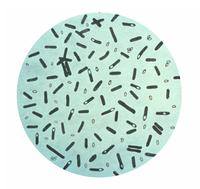
Photo from wikipedia
Investigating the chemical diversity of natural products from tropical environments is an inspiring approach to developing new drug candidates for neglected tropical diseases (NTDs). In the present study, phenotypic screenings… Click to show full abstract
Investigating the chemical diversity of natural products from tropical environments is an inspiring approach to developing new drug candidates for neglected tropical diseases (NTDs). In the present study, phenotypic screenings for antiprotozoal activity and a combination of computational and biological approaches enabled the identification and characterization of four cytochalasins, which are fungal metabolites from Brazilian biodiversity sources. Cytochalasins A-D exhibited IC50 values ranging from 2 to 20 μM against intracellular Trypanosoma cruzi and Leishmania infantum amastigotes, values comparable to those of the standard drugs benznidazole and miltefosine for Chagas disease and leishmaniasis, respectively. Furthermore, cytochalasins A-D reduced L. infantum infections by more than 80% in THP-1 cells, most likely due to the inhibition of phagocytosis by interactions with actin. Molecular modelling studies have provided useful insights into the mechanism of action of this class of compounds. Furthermore, cytochalasins A-D showed moderate cytotoxicity against normal cell lines (HFF-1, THP-1, and HepG2) and a good overall profile for oral bioavailability assessed in vitro. The results of this study support the use of natural products from Brazilian biodiversity sources to find potential drug candidates for two of the most important NTDs.
Journal Title: PLoS ONE
Year Published: 2022
Link to full text (if available)
Share on Social Media: Sign Up to like & get
recommendations!